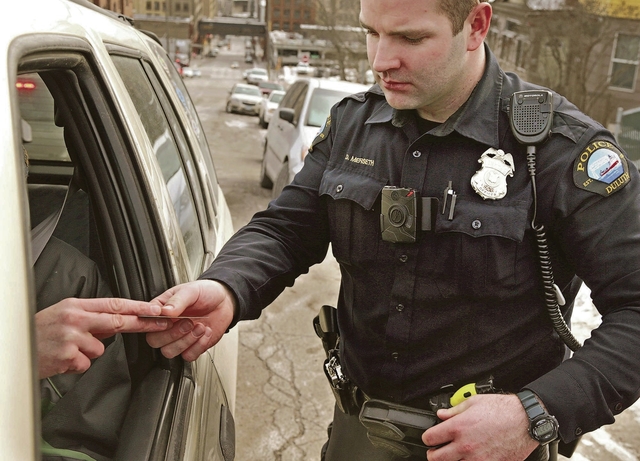Honolulu police are hoping to begin a body camera pilot program by the end of this year.
Police Maj. Andrew Lum, who heads the department’s Information Technology Division, said the department is testing vantage points by placing body cameras at eye, shoulder and chest levels on officers of various heights. The officers are then placed into a variety of scenarios, sometimes with other camera-equipped officers.
The recordings are analyzed for obstructions, visibility and other advantages or drawbacks, Lum said in an interview after giving a presentation recently about the body cameras to the Honolulu Police Commission.
The Honolulu Police Department is following police departments in Kauai, Maui and Hawaii island — all much smaller departments — that have already implemented or tested the technology.
About 100 of the 140 officers with the Kauai Police Department have been using collar-worn body cameras since December, a spokeswoman said.
The Maui Police Department, which has about 350 officers, is conducting a one-month study on body-worn cameras. On Hawaii island, police already completed a pilot program but have yet to purchase cameras for the department’s 440 officers.
Honolulu’s police force is much larger, with about 2,000 officers, and one of the biggest challenges, HPD officials say, is figuring out the best way to manage and store the data.
Last year, only about 18 percent of law enforcement agencies had fully operational body worn camera programs, according to a survey by the Major Cities Chiefs Association and Major County Sheriffs’ Association.
Lum said the department expects to finish testing vantage points this month and has almost completed an administrative policy that tells officers how to use the cameras.
In about two months HPD may be able to make a request for proposals and select a vendor for the hardware, Lum said. At that time HPD will have an idea of the pilot project’s cost.
He said the pilot could begin in November and last three to six months.
During the pilot the department will need only about a month to decide what camera hardware to go with. Testing the policy, however, will take months.
“We have to ascertain whether or not what we have written works out in the field,” Lum told the commission.
After the pilot project is complete, the department will decide how to store the data — either in-house or in “the cloud” using a third party. While in-house storage would require additional manpower and costs, the data would be accessible from inside the department rather than on a server on the mainland.
Police Chief Louis Kealoha told the commission that on average, one person is needed to catalog and manage the data from video for every 10 officers.
“It becomes very costly,” he said. “This project is definitely going to run into the millions.”
Lum estimated 500 cameras used over three shifts a day would create about 4,000 terabytes of data a year (one terabyte is 1,000 gigabytes). He said managing and storing that data could cost from $1.5 million to $3 million annually.
Lum said it’s been a challenge to implement body cameras for the department because the technology hasn’t been around long enough for best practices to be established. He said that some departments that adopted the technology later abandoned it because it was too expensive.
HPD began looking into body cameras in December and was delayed by legislation that would have hampered the department’s use of the technology, Lum said. He added that the department is still working to change a city law that limits the ability of officers to record in public.
After the pilot project is compete, the department will compare the costs and impacts and determine whether HPD will adopt the technology. A police spokeswoman said HPD looked into dashboard cameras more than 10 years ago and decided at the time not to purchase the technology. It wasn’t clear why HPD rejected dashboard cameras.
Lum said another obstacle for the pilot project was cleared in June when the Hawaii Labor Relations Board ruled in favor of the Kauai Police Department using body cameras. In that case the State of Hawaii Organization of Police Officers, which supports body cameras, filed a complaint with the board, claiming the union needed to approve KPD’s use of the cameras. The board ruled that KPD didn’t need the union’s approval.

